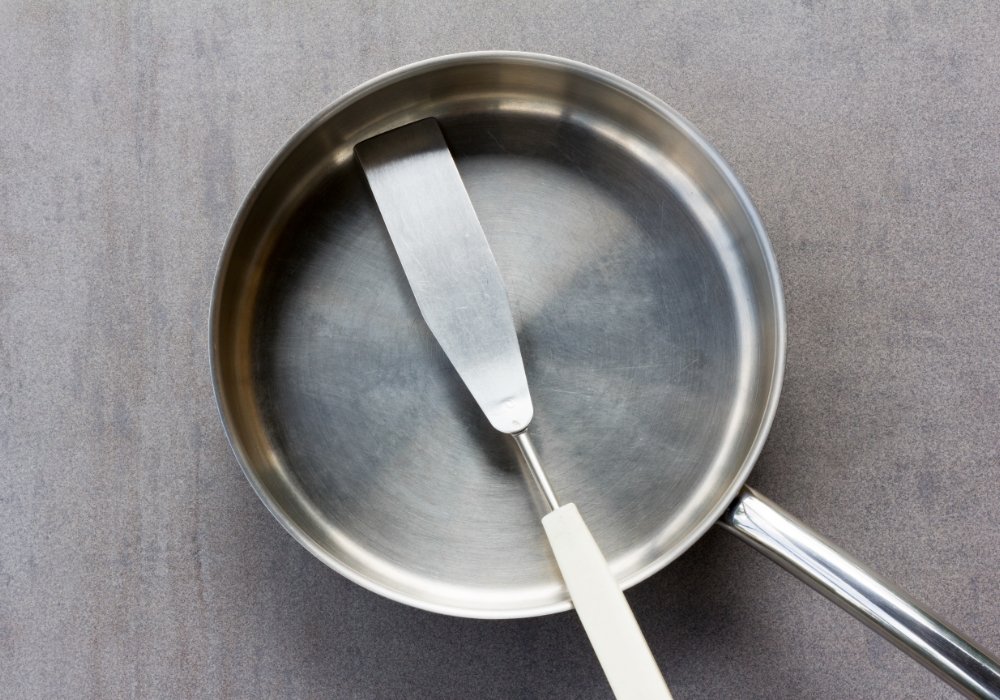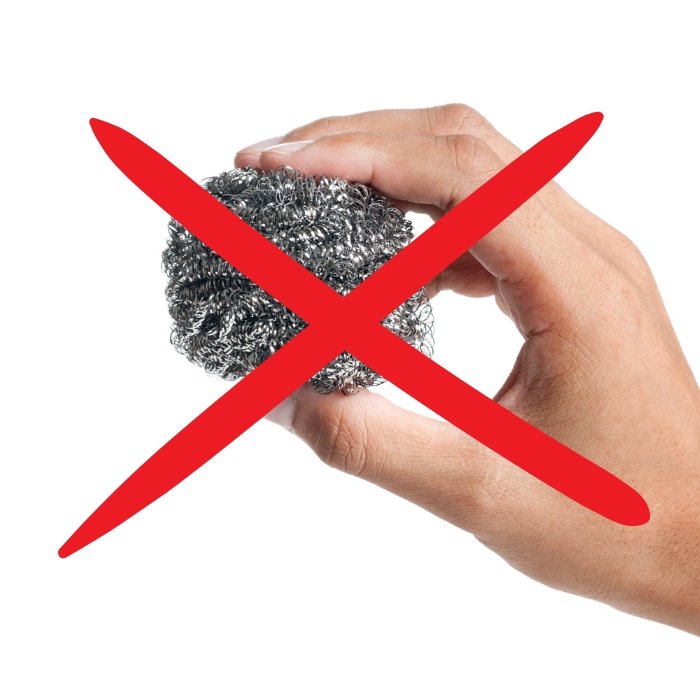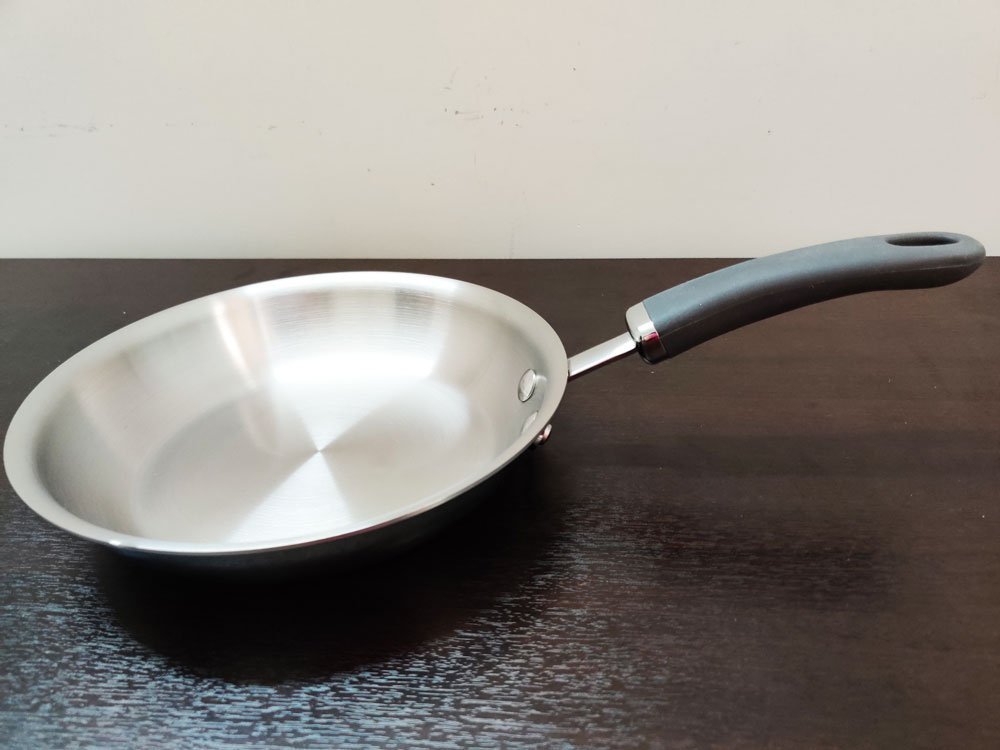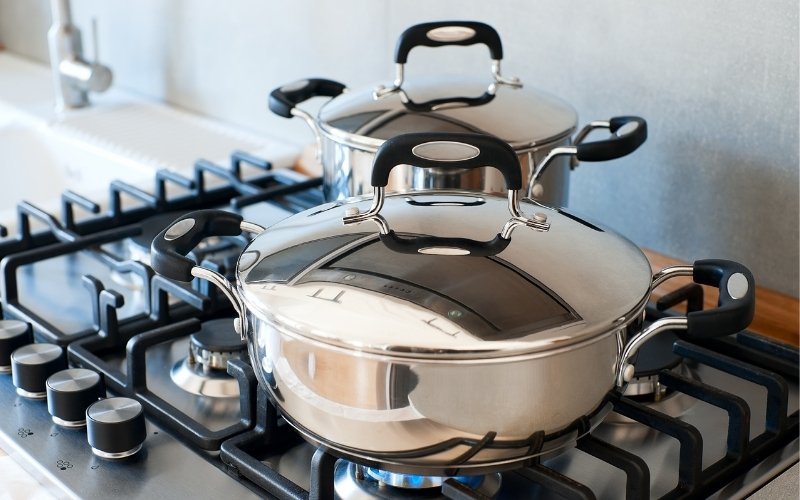High-quality stainless steel cookware is known for its long-lasting durability. But what exactly constitutes “well-constructed” cookware? Ideally, it refers to cookware made with a triply construction, which features a layer of aluminum sandwiched between two layers of stainless steel, one on top and one on the bottom. While these triply options tend to be pricier than standard stainless steel cookware with a single-layer bottom, they are an investment that can endure a lifetime with proper maintenance.
In addition, thicker stainless steel cookware with a copper bottom is also quite durable. On the other hand, cookware with a disc-bottom design, while more budget-friendly, tends to discolor quickly and may have the disc detach from the bottom after just a few years of use.
So how do you care for your precious stainless steel cookware so that they last a lifetime? Let us explore.
Avoid Banging on Stainless Steel Cookware

Despite common assumptions, stainless steel is not exceptionally hard. It registers an 8 on the Mohs scale of mineral hardness, which places it above aluminum and copper. However, this does not mean that stainless steel cookware can endure continuous banging from utensils such as steel spatulas.
Avoid Steel Wool

Using steel wool to clean stainless steel cookware can result in unsightly scratches and potentially lead to rusting. This is because the constant scrubbing can wear away the protective layer of chromium on the cookware’s surface. To maintain the appearance and longevity of your stainless steel cookware, it’s advisable to opt for the green portion of a Scotch-Brite pad or any mildly abrasive scrubbing tool when cleaning.
Related reading: Best Stainless Steel Cookware In India
Dishwasher or Not?

Many triply cookware sets feature an exterior surface with a mirror finish, and it’s important to note that constant exposure to the chemicals in dishwasher detergent and water spray may lead to visible scratches on the cookware’s exterior. However, these scratches typically don’t affect the cookware’s durability or performance.
If you’re inclined to take extra care of your cookware and maintain its pristine appearance, it’s advisable to avoid using the dishwasher altogether. Instead, hand washing with a gentle detergent and a soft sponge can help preserve its exterior finish.
On the other hand, if you’re more concerned about convenience and don’t mind a few surface scratches, you can opt to run your triply cookware through the dishwasher periodically. While this may result in some cosmetic wear over time, it won’t compromise the cookware’s functionality.
Do Not Boil Salt Water

When boiling saltwater in stainless steel cookware, there is a potential for the chromium coating to react with oxygen and salt, leading to the development of black pitting marks on the cookware’s surface. These marks can be irreversible. However, you can take steps to prevent this issue by adding salt to the water only after it has started boiling. By doing so, you reduce the presence of oxygen in the water during the initial heating, which can help mitigate the reaction and the formation of black pits on the stainless steel cookware.
Related reading: Are Triply Stainless Steel Pressure Cookers Worth It?
Removing Discoloration

To effectively address the issue of rainbow-like discoloration, a common occurrence resulting from exposure to high temperatures, as well as combatting white deposits caused by hard water, consider utilizing a simple yet highly efficient solution: diluted vinegar. The process involves mixing equal parts of white vinegar and water, creating a gentle yet effective cleaning agent. By soaking the affected stainless steel cookware in this mixture, the vinegar works to dissolve the stains and mineral deposits over a short period. After a brief soak, a gentle scrub with a soft cloth or sponge can be employed to remove the blemishes, followed by thorough rinsing and drying. This method not only restores the cookware’s original shine but also helps maintain its pristine appearance, ensuring its long-lasting durability in your kitchen.
Avoid Drastic Temperature Differences

Subjecting a hot pan to cold water or rapidly heating a cold pan can lead to differential metal expansion rates, potentially causing the cookware to warp and bend. Warped cookware can be problematic as it tends to collect oil around its edges and may result in uneven heating of food. To preserve the integrity of your cookware and prevent warping, it is advisable to wait until the cookware has cooled down before cleaning it. This simple precaution can help maintain the flatness of your cookware, ensuring consistent cooking results and prolonging its lifespan.
Always Preheat

A common concern for first-time users of triply stainless steel cookware is that food sticks to the surface. To prevent this, it’s important to follow a simple yet effective preheating process. Begin by preheating the cookware in a way that, when you sprinkle water onto it, the water should sizzle like beads and not evaporate quickly. Once the cookware is sufficiently preheated, add a thin layer of oil, enough to make it sizzle as well. Now, you can proceed to cook your food. This preheating and oiling process helps create a temporary non-stick surface on the stainless steel, reducing the likelihood of food sticking and making your cooking experience smoother and more enjoyable.
Removing Difficult Stains

When you encounter burnt food residue on your stainless steel cookware, it’s crucial to take a gentle and effective approach to cleaning without causing damage. Firstly, avoid aggressive scrubbing, as this can harm the cookware’s surface.
Instead, start by generously sprinkling baking soda over the burnt area, ensuring complete coverage. Next, add enough water to submerge the burnt residue. Place the cookware on the stovetop and bring the water to a boil, allowing it to simmer for a few minutes. When simmering, use a spatula or wooden spoon to gently scrape off the loosened burnt food particles.
To address any remaining residues, lightly scrub the affected area with a Scotchbrite or a non-abrasive scrubbing pad. It’s essential to be delicate during this process to prevent scratches. Finally, rinse the cookware thoroughly with warm water. If you don’t have baking soda, a few drops of dishwashing liquid can serve as an alternative solution.
